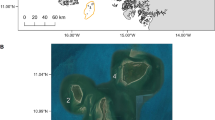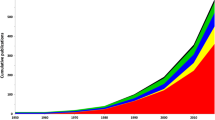Abstract
Habitat use of the tapertail anchovy (Coilia mystus Linnaeus, 1758) from the Oujiang River Estuary and the Zhujiang (Pearl) River Estuary was studied by examining the environmental signatures of Sr and Ca in otoliths using electron probe microanalysis. Individuals from the Oujiang River had higher and varied Sr:Ca ratios (expressed as (Sr:Ca)×1 000, 3.83-13.0 average) in the otolith core regions, suggesting that they were born in brackish or sea waters, and that a freshwater habitat might not be necessary for egg hatching and larval growth. While, individuals from the Zhujiang River had lower Sr:Ca ratios (0.39–2.51 average) in the core regions, suggesting a freshwater origin. After hatching, anchovies from the Zhujiang River migrate downstream to the river estuary close to brackish water. Our results demonstrated varied habitat use for spawning during stages of early life history between the two populations, and suggested that such variations are promoting diversity of life history strategies of this species.
Similar content being viewed by others
References
Arai T, Chino N. 2018. Opportunistic migration and habitat use of the giant mottled eel Anguilla marmorata (Teleostei: Elopo-morpha). Scientific Reports, 8: 5666, doi: 10.1038/s41598-018-24011-z
Callahan J, Dai Minhan, Chen R F, et al. 2004. Distribution of dissolved organic matter in the Pearl River estuary, China. Marine Chemistry, 89(1–4): 211–224
Campana S E. 1999. Chemistry and composition of fish otoliths: pathways, mechanisms and applications. Marine Ecology Progress Series, 188: 263–297, doi: 10.3354/meps188263
Campana S E, Thorrold S R. 2001. Otoliths, increments, and elements: keys to a comprehensive understanding of fish populations?. Canadian Journal of Fisheries and Aquatic Sciences, 58(1): 30–38, doi: 10.1139/f00-177
Chatterjee M, Ghosh P, Ramdas L, et al. 2015. Isotopic and geochem-ical characterization of invader tilapia fishes from water bodies of West Bengal and Karnataka, India. Environmental Monitoring and Assessment, 187: 712, doi: 10.1007/s10661-015-4929-0
Chen Fang, Cheng Qiqun. 2012. Microsatellite DNA diversity of Coil-ia mystus (Clupeiformes: Engraulidae) in three Chinese estuaries. Iranian Journal of Fisheries Sciences, 11(2): 271–282
Chen Tingting, Jiang Tao, Liu Hongbo, et al. 2016. Do all long super-maxilla-type estuarine tapertail anchovies (Coilia nasus Tem-minck et Schlegel, 1846) migrate anadromously?. Journal of Applied Ichthyology, 33(2): 270–273, doi: 10.1111/jai.13309
Cheng Qiqun, Ma Chunyan, Cheng Huaping, et al. 2008. Mitochon-drial DNA diversity of Coilia mystus (Clupeiformes: Engraulid-ae) in three Chinese estuaries. Environmental Biology of Fishes, 83(3): 277–282, doi: 10.1007/s10641-008-9332-z
Chino N, McCarthy T K, Arai T. 2017. Analysis of fluvial migration of the Irish pollan Coregonus autumnalis, using Sr:Ca ratios of otolith. Journal of Applied Animal Research, 46(1): 609–612, doi: 10.1080/09712119.2017.1369089
He Wenping, Li Yuxuan, Liu Ming, et al. 2011. Reproductive biology of Coilia mystus (Linnaeus) from the Yangtze Estuary, China: responses to overexploitation. Journal of Applied Ichthyology, 27(5): 1197–1202, doi: 10.1111/j.1439-0426.2011.01767.x
Jiang Tao, Liu Hongbo, Huang Honghui, et al. 2015. Otolith micro-chemistry of Coilia grayii from the Pearl River estuary, China. Acta Hydrobiologica Sinica (in Chinese), 39(4): 816–821
Jiang Tao, Liu Hongbo, Lu Mingjie, et al. 2016. A possible connectivity among estuarine tapertail anchovy (Coilia nasus) populations in the Yangtze River, Yellow Sea, and Poyang Lake. Estuaries and Coasts, 39(6): 1762–1768, doi: 10.1007/s12237-016-0107-z
Jiang Tao, Liu Hongbo, Shen Xinqiang, et al. 2014. Life history variations among different populations of Coilia nasus along the Chinese Coast inferred from otolith microchemistry. Journal of the Faculty of Agriculture, Kyushu University, 59(2): 383–389
Jiang Hengzhi, Shen Yongming, Wang Shoudong. 2009. Numerical simulation study on three-dimensional tidal flow and salinity in the Oujiang estuary. Journal of Hydrodynamics (in Chinese), 24(1): 63–70
Kubota K, Yokoyama Y, Kawakubo Y, et al. 2015. Migration history of an ariid Indian catfish reconstructed by otolith Sr/Ca and δ18O micro-analysis. Geochemical Journal, 49(5): 469–480, doi: 10.2343/geochemj.2.0371
Limburg K E, Turner S M. 2016. How common is “Non-textbook” migration in Hudson River blueback herring?. Estuaries and Coasts, 39(4): 1262–1270, doi: 10.1007/s12237-016-0068-2
Liu Hongbo, Jiang Tao, Huang Honghui, et al. 2015. Estuarine dependency in Collichthys lucidus of the Yangtze River estuary as revealed by the environmental signature of otolith strontium and calcium. Environmental Biology of Fishes, 98(1): 165–172, doi: 10.1007/s10641-014-0246-7
Liu Hongbo, Jiang Tao, Yang Jian. 2018. Unravelling habitat use of Coilia nasus from the Rokkaku River and Chikugo River estuaries of Japan by otolith strontium and calcium. Acta Oceanolo-gica Sinica, 37(6): 52–60, doi: 10.1007/s13131-018-1190-8
Rodionov S N. 2004. A sequential algorithm for testing climate regime shifts. Geophysical Research Letters, 31(9): L09204
Secor D H, Rooker J R. 2000. Is otolith strontium a useful scalar of life cycles in estuarine fishes?. Fisheries Research, 46(1-3): 359–371
Song Lanlan, Xu Qun, Lu Guihua. 2012. Research on habitat fragmentation in Oujiang River estuary. Journal of China Hydrology (in Chinese), 32(5): 17–21
Sousa R G C, Humston R, Freitas C E C. 2016. Movement patterns of adult peacock bass Cichla temensis between tributaries of the middle Negro River basin (Amazonas-Brazil): an otolith geo-chemical analysis. Fisheries Management and Ecology, 23(1): 76–87, doi: 10.1111/fme.2016.23.issue-1
Tsukamoto K, Chow S, Otake T, et al. 2011. Oceanic spawning ecology of freshwater eels in the western North Pacific. Nature Communications, 2: 179, doi: 10.1038/ncomms1174
Xiong Ying, Yang Jian, Jiang Tao, et al. 2017. Early life history of the small yellow croaker (Larimichthys polyactis) in sandy ridges of the South Yellow Sea. Marine Biology Research, 13(9): 993–1002, doi: 10.1080/17451000.2017.1319067
Yang Jian, Arai T, Liu Hongbo, et al. 2006a. Reconstructing habitat use of Coilia mystus and Coilia ectenes of the Yangtze River estuary, and of Coilia ectenes of Taihu Lake, based on otolith strontium and calcium. Journal of Fish Biology, 69(4): 1120–1135, doi: 10.1111/jfb.2006.69.issue-4
Yang Jian, Arai T, Liu Hongbo, et al. 2006b. Environmental signature in the otolith elemental fingerprint of the tapertail anchovy, Coilia mystus, from the Changjiang estuary, China. Journal of Applied Ichthyology, 22(5): 459–462, doi: 10.1111/jai.2006.22. issue-5
Yang Jian, Jiang Tao, Liu Hongbo. 2011. Are there habitat salinity markers of the Sr: Caratio in the otolith of wild diadromous fishes? A literature survey. Ichthyological Research, 58(3): 291–294, doi: 10.1007/s10228-011-0220-8
Yuan Chuanmi, Qin Anling. 1984. Ecological habits and distribution of Coilia along the Chinese coast and its changes of output. Marine Sciences (in Chinese), (5): 35–37
Zeng Qiang, Dong Fangyong. 1993. Study on the biological characteristics and factor correlation of Coilia mystus propagating population. Journal of Lake Sciences (in Chinese), 5(2): 164–170, doi: 10.18307/1993.0209
Zhong Wei, Shao Xinbin, Hu Lihua, et al. 2009. Biological characteristics of Coilia mystus in the Oujiang River. Journal of Wenzhou University (Natural Sciences) (in Chinese), 30(4): 14–18
Acknowledgements
We thank Xueliang Chai for his support on fish sampling in the Oujiang River Estuary. We also thank Momodou S Jallow and Horace Mensah for critically reading and providing comments that improved the manuscript.
Author information
Authors and Affiliations
Corresponding author
Additional information
Foundation item: The China Central Governmental Research Institutional Basic Special Research Project from Public Welfare Fund under contract No. 2016PT01; the Open Project for Key Laboratory of South China Sea Fishery Research Exploitation & Utilization of Ministry of Agriculture under contract No. FREU2015-07; the Central Public-interest Scientific Institution Based Research Fund, Freshwater Fisheries Research Center, CAFS under contract No. 2017JBFR02; the National Natural Science Foundation of China under contract No. 31602159; the Natural Science Foundation of Jiangsu Province, China under contract No. BK20160204.
Rights and permissions
About this article
Cite this article
Jiang, T., Liu, H., Huang, H. et al. Migration patterns and habitat use of the tapertail anchovy Coilia mystus in the Oujiang River Estuary and the Zhujiang River Estuary, China. Acta Oceanol. Sin. 38, 35–40 (2019). https://doi.org/10.1007/s13131-019-1436-0
Received:
Accepted:
Published:
Issue Date:
DOI: https://doi.org/10.1007/s13131-019-1436-0




